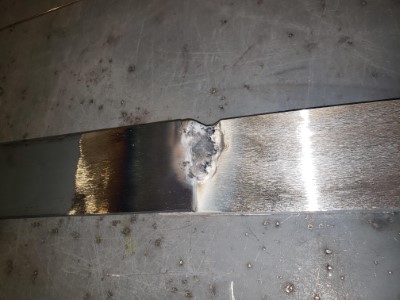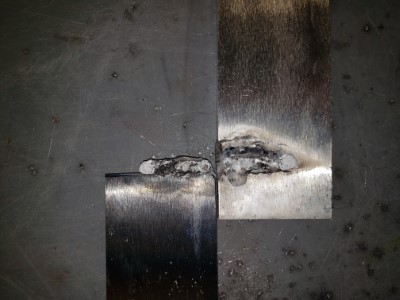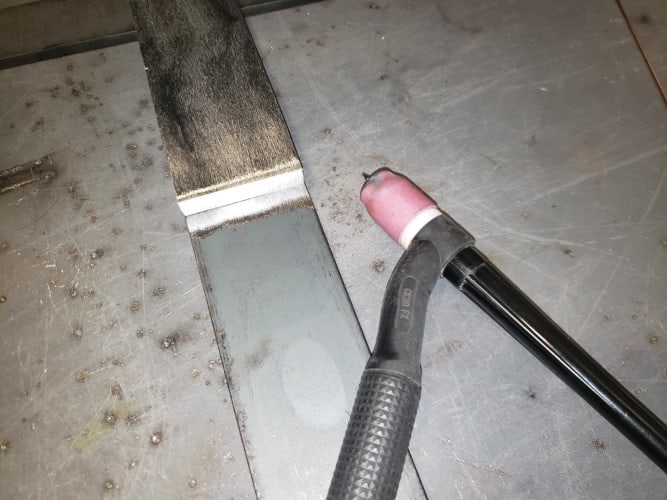Both aluminum and steel are very weldable metals. There are no problems whatsoever in welding steel to steel, and aluminum to aluminum. But what happens when you need to cross the boundaries and join these dissimilar metals?
Can steel be welded to aluminum? Steel cannot be welded to aluminum by using conventional welding techniques, like SMAW (arc welding), GMAW (MIG) or GTAW (TIG). However, there are some workarounds and alternatives that might provide acceptable results.
In this article, I’ll go over what processes can actually weld these two dissimilar materials together, what you need to watch out for, and what practical alternatives are out there.
Table of Contents
Why You Can’t Weld Steel to Aluminum
One of the main reasons that you can’t weld steel to aluminum with the welder in your garage is that the melting temperatures between the two metals are just too extreme.
Just for the sake of settling any argument, here’s what happens when you try to TIG weld the two metals together:

I ended up using a steel filler. The aluminum underneath the steel was just melting away before the steel even formed a puddle. I compensated by adding a ton of steel filler to get the two materials to meet up.
Aluminum melts around 1200 F, and steel melts around 2700 F. That usually means that the aluminum will completely melt away before the steel even starts to glow. Even if you can get the metal to pool together, it won’t fuse. You’ll just get globs of steel that are very lightly held on by messy, garbage aluminum.
The result is a “weld” that snaps when you look at it the wrong way. See below.

This literally took no force to break apart. Even though it looked like the material globbed together (technical term right there), the metals just didn’t fuse.
Another reason why this doesn’t really work is that the thermal expansion of aluminum vs steel is hugely different. Aluminum will grow about twice as much as steel as it heats up. That means that as the metal cools off, the welded area is likely to crack under the strain.
There are also a bunch of other reasons why welding steel to aluminum doesn’t really work, like different thermal conductivities, different lattice transformations, subsidiary precipitates, and other sciency things.
Point is, you can’t TIG, MIG, or stick weld it. Unless you use bimetallic transition inserts, that is.
Bimetallic Transitions
This is a solution that’s most commonly used on ships, heat exchangers, and pipelines.
Essentially it’s just an insert that’s steel on one side, and aluminum on the other. They’re thick enough that you can use a regular GMAW or GTAW technique and weld the steel side to steel, and the aluminum side to aluminum.
These inserts are pre-bonded, usually by using a hot rolling or hot pressure welding technique (explosion welding). They can actually handle a surprising amount of force, and the welded connections with these inserts are very sturdy. According to some MIL specs, these bonded inserts are supposed to have a minimum of about 1/4 the tensile strength of aluminum, although they’ll often come in at closer to 1/2.
This video gives a really good explanation of how this explosion welding process is done, and what results from this process:
If you need to weld aluminum to steel, this is probably your best bet.
The down side?
These are nearly impossible to source if you’re a small job shop or hobbyist. They’re specialty products that are usually custom-made and very expensive, with massive minimum order quantities.
Aluminizing
This isn’t a word that I just made up. Aluminized steel is a metal that’s most commonly gone through a hot-dip process with an aluminum-silicon alloy. There are other ways of doing it too, like galvanic coating, but the hot-dipping method is the most common.
This is not a practical way of welding large pieces of steel to large pieces of aluminum.
The reason that I’m bringing it up is that there seems to be some misinformation floating around the internet on this. There are a handful of sites saying that you can weld a block of aluminum on to a piece of aluminized steel. You can’t. All you can do is weld aluminized steel to regular steel.
The reason is that when you get up to a temperature hot enough to melt the underlying steel, the thin aluminum coating is long since burned away. It just doesn’t work.
Brazing
To be clear, this does require some skill to get right. Brazing could be a possible solution when you need something like a weld in joining steel to aluminum.
However, brazing will not have a strength comparable to explosion welding. You’ll need a good amount of surface area for the pieces to stick together, and a strong mechanical fit will go a long way in preventing things from falling apart.
Assuming that you’re already familiar with how brazing works, here’s a basic overview of how to do it:
- Start off by wetting the steel with a 56% silver braze.
- Use an aluminum brazing alloy like Aluxcor 4047 to join the aluminum to the wetted steel
You’ll probably find much better results with this two-stage method than with a single stage brazing process. For the single stage brazes, the braze itself is actually pretty soft and you won’t get as much holding power.
Bonding
While this won’t give you a particularly strong connection, using an epoxy or another kind of bonding agent might do the trick for you.
Again, you need a lot of surface area for this to work properly, but a good ‘ol tube of JB Weld might be all that you need to get the job done. Make sure that you really take your time in thoroughly cleaning both pieces, and ideally scuff up the surfaces to be bonded for more holding power.
There are also some higher-end products out there. 3M industrial structural epoxies are great, but they can be expensive and often have long cure times.
Mechanical Fastening
If at all humanly possible, please just use mechanical fastening. The easiest way to join aluminum to steel is just a trip to the hardware store away.
Whether you’re using bolts, rivets, folded seams, or whatever else tickles your fancy, mechanical fastening is by far the best, cheapest, fastest, and easiest way to join dissimilar materials.
Galvanic Corrosion
This is one thing that you should be aware of when you’re working with steel and aluminum.
Usually steel is prone to rusting, and aluminum is generally considered to be corrosion-resistant.
Join the two metals together and add salt water, though, and you’ll notice significant corrosion on the aluminum. This is due to galvanic corrosion.
Fancypants explanation: the steel acts as a cathode and the aluminum acts as an anode, and an electrolyte (like salt water) provides a means for ion migration. This results in the oxidation of the anode (aluminum).
Understandable explanation: The aluminum will corrode in the area where it contacts the steel if it’s around salt water.
In many applications, this isn’t a big deal. If the environment has salt, though, (including road salt on cars) you can run in to problems.
The workaround is to isolate the two materials by paint or a piece of plastic to prevent any kind of electrical current from passing between the two. You can use a continuity tester on a multimeter to check that you’ve properly isolated the metals.

